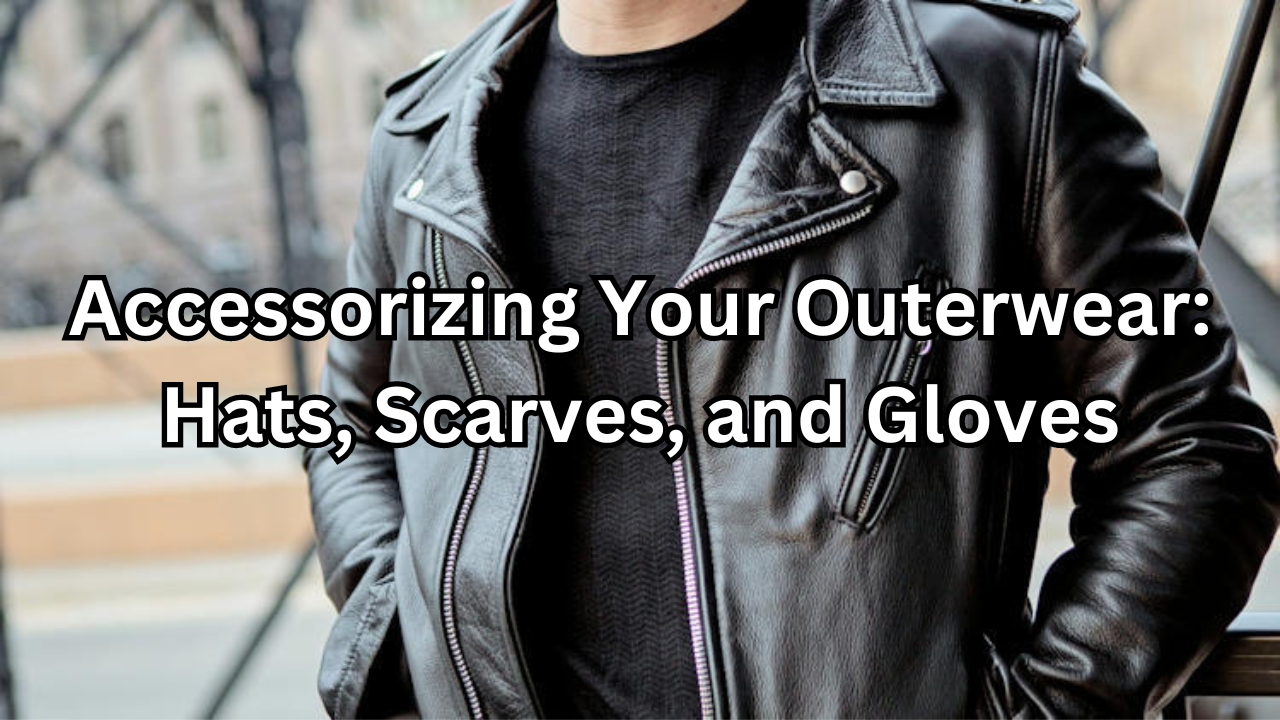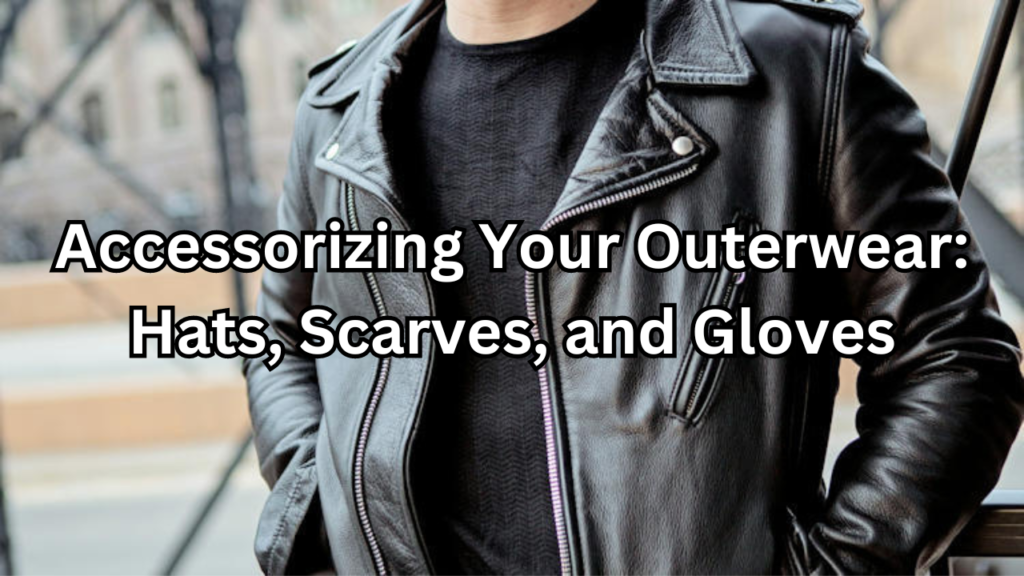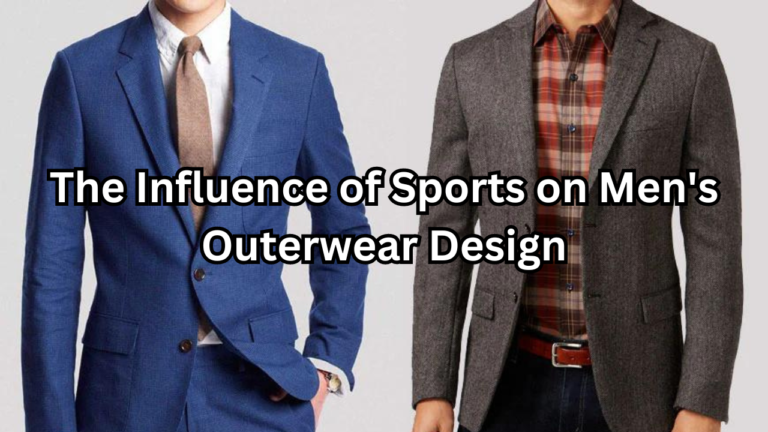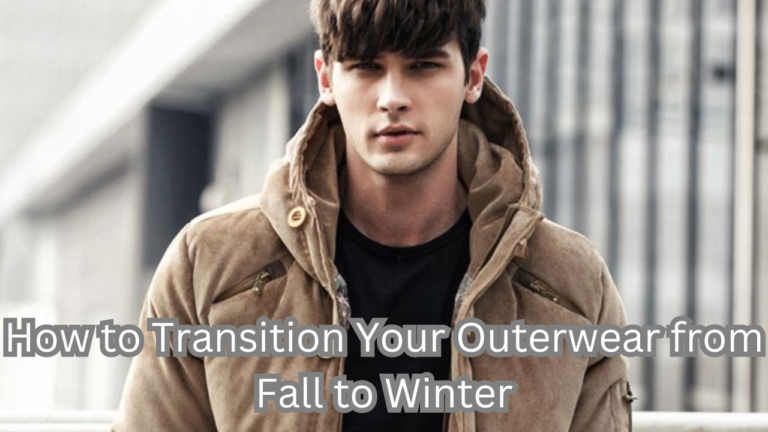

Table of Contents
Introduction
Importance of Accessorizing Your Outerwear
Accessorizing your outerwear play a pivotal role in elevating the style quotient of our outerwear. They serve as the finishing touches, transforming a simple coat or jacket into a fashion statement. Whether it’s adding a pop of color, texture, or personality, accessories have the power to enhance our overall look and make a lasting impression.
Overview of hats, scarves, and gloves as key accessories
Among the myriad of accessories available, hats, scarves, and gloves stand out as essential companions to our outerwear. Each serves a unique purpose beyond mere adornment. Hats shield us from the sun or cold winds, scarves provide warmth and style, and gloves offer protection against chilly temperatures. Together, they form a trifecta of fashion and function, completing our winter ensembles with flair.
Purpose of the guide
In this guide, we delve into the art of accessorizing your outerwear with hats, scarves, and gloves, exploring the various styles, materials, and techniques to help you master the art of winter accessorizing. Whether you’re looking to stay cozy during frosty weather or make a fashion Men statement on the streets, this guide will equip you with the knowledge and inspiration to accessorize your outerwear with confidence and panache.
Choosing the Right Hat
Selecting the perfect hat to complement your outerwear is essential for both style and functionality. Here’s how to navigate the vast array of options and find the ideal hat for any occasion:
Consider the Weather: The first step in choosing the right hat is to consider the weather conditions. A cozy knit beanie or a wool fedora might be perfect for chilly days, while a wide-brimmed sun hat is ideal for sunny outings.
Match the Style: Hats come in various styles, from casual beanies to sophisticated fedoras. Choose a hat style that reflects your personal aesthetic and complements the vibe of your outfit. Experiment with different shapes and silhouettes to find the one that suits you best.
Pay Attention to Material: The material of the hat can significantly impact its look and feel. Wool hats are perfect for insulation and warmth, while straw hats are lightweight and breathable, making them ideal for warmer weather. Consider the material of your outerwear and opt for a hat that complements it seamlessly.
Fit Matters: A well-fitting hat not only looks better but also feels more comfortable. Pay attention to the size and shape of your head when trying on hats, and don’t be afraid to adjust or try different sizes until you find the perfect fit.
Versatility is Key: Choose a hat that can easily transition from day to night and from casual to formal occasions. A classic black fedora or a neutral-colored beanie can effortlessly elevate any outfit, making it a versatile addition to your accessory collection.
Types of Hats
Hats come in a wide range of styles, each with its own unique charm and purpose. Here are some popular types of hats to consider when accessorizing your outerwear:
Beanie: A staple for colder weather, beanies are snug-fitting hats typically made of knit fabric. They come in various colors and designs, making them versatile for casual, everyday wear.
Fedora: A timeless classic, the fedora features a wide brim and a pinched crown, giving it a sophisticated and vintage-inspired look. Fedoras come in different materials, including wool felt and straw, making them suitable for both formal and casual occasions.
Baseball Cap: Casual and sporty, baseball caps are characterized by their rounded crown and stiff brim. They’re perfect for outdoor activities and adding a laid-back vibe to your outfit.
Bucket Hat: With its downward-sloping brim and relaxed fit, the bucket hat offers a cool and casual aesthetic. It’s often made of cotton or canvas, making it lightweight and comfortable for warmer weather.
Beret: A symbol of French chic, the beret is a soft, round hat with a flat crown. It adds a touch of elegance to any ensemble and can be worn tilted to the side or pulled straight for a classic look.
Panama Hat: Lightweight and breathable, the Panama hat is woven from straw and features a wide brim and a tapered crown. It’s perfect for sunny days and adds a touch of sophistication to summer outfits.
Considerations for Selecting the Appropriate Hat
When choosing a hat to complement your outerwear, consider the following factors to ensure the perfect match:
Weather Conditions: Select a hat that provides adequate protection against the elements. For cold weather, opt for insulated hats like beanies or fedoras made of wool. In warmer weather, choose breathable hats like baseball caps or Panama hats to stay cool and comfortable.
Face Shape and Features: Take your face shape and features into account when selecting a hat style. For example, those with round faces may prefer hats with structured crowns like fedoras to add height, while individuals with angular features may opt for softer styles like beanies or bucket hats to balance their look.
Tips for Styling Hats with Different Outerwear Options
Styling hats with your outerwear can instantly elevate your look and add a touch of personality to your ensemble. Here are some tips for pairing hats with different types of outerwear:
Beanies with Casual Jackets: Pair a cozy knit beanie with your favorite casual jacket for a laid-back and effortlessly cool look. Opt for neutral colors like black, gray, or navy to complement the colors in your jacket.
Fedora with Trench Coats: Add a touch of sophistication to your trench coat ensemble by topping it off with a classic fedora. Choose a fedora in a neutral tone like camel or taupe to complement the timeless elegance of the trench coat.
Baseball Caps with Activewear: Complete your activewear look with a sporty baseball cap. Whether you’re going for a jog or running errands, a baseball cap adds a sporty-chic vibe to your outfit and provides protection from the sun.
Bucket Hats with Denim Jackets: Embrace retro vibes by pairing a denim jacket with a trendy bucket hat. Opt for a bucket hat in a fun print or vibrant color to add a playful twist to your denim-on-denim ensemble.
Berets with Tailored Coats: Elevate your winter outerwear with a stylish beret. Pair a wool beret with a tailored coat for a sophisticated Parisian-inspired look that exudes elegance and charm.
Panama Hats with Sundresses: Complete your summer sundress ensemble with a chic Panama hat. The wide brim provides sun protection while adding a touch of glamour to your outfit. Choose a Panama hat in a light-colored straw for a fresh and summery vibe.
Mix and Match: Don’t be afraid to mix and match hat styles with different outerwear options to create unique and unexpected combinations. Experiment with textures, colors, and proportions to express your personal style and make a statement with your outfit.
Selecting the Perfect Scarf
A. Various Scarf Materials and Textures
When selecting a scarf, consider the material and texture to ensure both style and comfort. Here are some common scarf materials and their characteristics:
Wool: Wool scarves are perfect for colder climates as they provide warmth and insulation. Look for soft merino wool or cozy cashmere for a luxurious feel.
Silk: Silk scarves add elegance and sophistication to any outfit. They’re lightweight and breathable, making them ideal for transitional seasons like spring and fall.
Cotton: Cotton scarves are lightweight and versatile, making them suitable for year-round wear. They come in a variety of colors and prints, making them perfect for adding a pop of color or pattern to your outfit.
Acrylic: Acrylic scarves mimic the look and feel of wool but are often more affordable. They’re easy to care for and come in a wide range of colors and textures.
Lengths and Styles of Scarves
Scarves come in various lengths and styles, allowing for versatility in how they’re worn. Common scarf styles include:
Rectangular Scarves: Rectangular scarves are the most traditional style and can be worn in a variety of ways, including draped loosely around the neck or tied in a knot.
Infinity Scarves: Infinity scarves are circular in shape and loop around the neck for a cozy and snug fit. They’re perfect for adding warmth and style to your winter ensemble.
Blanket Scarves: Blanket scarves are oversized and usually square or rectangular in shape. They can be worn draped over the shoulders like a shawl or wrapped around the neck for extra warmth.
Matching Scarves with Coats and Jackets
When pairing scarves with coats and jackets, consider the color, texture, and style of both pieces. Opt for complementary colors and textures to create a cohesive look. For example, pair a chunky knit scarf with a wool coat for a cozy winter look, or a lightweight silk scarf with a leather jacket for a chic and edgy vibe.
Techniques for Tying Scarves Creatively
Get creative with how you tie your scarf to add visual interest to your outfit. Some popular scarf tying techniques include:
The Parisian Knot: Fold the scarf in half, drape it around your neck, and pull the loose ends through the loop. Adjust as needed for a snug and stylish look.
The Infinity Loop: Loop the scarf around your neck twice, creating a double loop, and adjust the ends for a balanced look.
The Side Knot: Drape the scarf around your neck, leaving one end longer than the other. Tie a loose knot on one side and let the ends hang for a casual and effortless look.
Experiment with different tying techniques to find the style that best suits your outfit and personal aesthetic.
Finding the Right Gloves
Types of Gloves
Gloves are essential accessories for keeping your hands warm and protected during cold weather. Here are some common types of gloves to consider:
Leather Gloves: Leather gloves are classic and versatile, suitable for both casual and formal occasions. They provide excellent warmth and durability, making them ideal for cold climates.
Knit Gloves: Knit gloves are lightweight and flexible, allowing for ease of movement and dexterity. They come in a variety of colors and styles, making them perfect for everyday wear.
Touchscreen Gloves: Touchscreen gloves are designed with special fingertips that allow you to use touchscreen devices without having to remove your gloves. They’re perfect for staying connected while on the go during chilly weather.
Ski Gloves: Ski gloves are insulated and waterproof, designed to keep your hands warm and dry during winter sports activities. They often feature additional features like wrist straps and grippy palms for enhanced functionality.
Driving Gloves: Driving gloves are designed with grip-enhancing palms and fingers to provide better control while driving. They’re typically made of leather or synthetic materials and come in a variety of styles to suit different preferences.
Considerations for Choosing Gloves
When selecting gloves, consider the following factors to ensure they meet your needs and preferences:
Warmth and Insulation: Choose gloves with adequate insulation to keep your hands warm in cold weather. Look for materials like wool, fleece, or Thinsulate™ for optimal warmth without bulkiness.
Flexibility and Dexterity: Opt for gloves that allow for flexibility and dexterity, especially if you need to use your hands for tasks like texting or handling objects. Knit gloves and touchscreen gloves are excellent choices for maintaining mobility while staying warm.
Style Compatibility with Outerwear: Consider the style and color of your outerwear when choosing gloves to ensure they complement your overall look. Leather gloves are versatile and pair well with most coats and jackets, while colorful knit gloves can add a pop of color to neutral outerwear.
Coordinating Gloves with Other Accessories
Coordinating gloves with other accessories can elevate your winter ensemble and tie your look together seamlessly. Here are some tips for achieving a cohesive and stylish look:
Matching Materials: Coordinate the materials of your gloves with other accessories for a cohesive look. For example, pair leather gloves with a leather belt or handbag for a polished and sophisticated ensemble. Similarly, if you’re wearing a wool scarf, opt for wool gloves to create harmony in your outfit.
Color Coordination: Choose gloves that complement the colors of your other accessories, such as your hat or scarf. Opt for neutral shades like black, brown, or gray for versatility, or add a pop of color with gloves that match or complement the accent colors in your outfit.
Pattern Play: Experiment with mixing and matching patterns to add visual interest to your outfit. Pair solid-colored gloves with a patterned scarf or hat for a dynamic and eye-catching look. Alternatively, match the pattern of your gloves with one of the accessories for a coordinated and cohesive ensemble.
Texture Contrast: Contrast the textures of your gloves with other accessories for added depth and dimension. Pair smooth leather gloves with a chunky knit scarf for an interesting juxtaposition of textures, or opt for suede gloves to complement a cozy wool coat.
Accessorize in Sets: Invest in accessory sets that include matching gloves, hats, and scarves for effortless coordination. Matching sets ensure that all your accessories complement each other perfectly, making it easy to put together a stylish and cohesive outfit.
Consider the Occasion: Tailor your accessory coordination to the occasion and dress code. For formal events, opt for sleek and polished accessories that complement your outerwear elegantly. For casual outings, embrace creativity and experiment with bold colors, patterns, and textures to showcase your personal style.
Tips for Overall Coordination
Creating Cohesive Looks with Hats, Scarves, and Gloves
Coordinate your hats, scarves, and gloves to create cohesive and stylish winter looks. Choose accessories that complement each other in terms of color, texture, and style. For example, pair a wool fedora with a matching scarf and leather gloves for a polished and put-together ensemble.
Mixing and Matching Colors and Patterns
Experiment with mixing and matching colors and patterns to add visual interest to your outfits. Don’t be afraid to combine bold colors or mix different patterns like stripes, plaids, and florals. Just ensure that the colors and patterns harmonize well together for a cohesive look.
Layering Accessories for Added Warmth and Style
Layering accessories not only adds warmth but also creates dimension and depth to your outfit. Pair a chunky knit scarf with a sleek beanie and textured gloves for a cozy and layered look. Experiment with different lengths and textures to create visual interest while staying warm and stylish.
Incorporating Seasonal Trends
Stay on-trend by incorporating seasonal trends into your accessory rotation. Whether it’s embracing faux fur accents, sporting oversized knits, or adding metallic touches, look for accessories that reflect current fashion trends while still complementing your personal style. Don’t forget to have fun and experiment with new looks to keep your winter wardrobe fresh and exciting.
Care and Maintenance
Proper Storage of Hats, Scarves, and Gloves
To maintain the quality and shape of your hats, scarves, and gloves, it’s important to store them properly when not in use. Here are some tips for storing your winter accessories:
Hat Storage: Store hats in a cool, dry place away from direct sunlight to prevent fading and distortion. Consider using a hat box or shelf to help maintain their shape and protect them from dust and debris.
Scarf Storage: Hang scarves on a scarf hanger or fold them neatly and store them in a drawer or closet. Avoid hanging scarves on hooks or hangers with sharp edges that can snag delicate fabrics.
Glove Storage: Keep gloves together as a pair and store them in a drawer or bin to prevent them from getting lost or mismatched. Avoid folding gloves excessively to prevent creasing and maintain their shape.
Cleaning and Upkeep Guidelines for Different Materials
Proper cleaning and upkeep are essential for prolonging the life of your winter accessories. Here are some general guidelines for cleaning different materials:
Wool: Hand wash wool hats, scarves, and gloves in cold water with a gentle detergent, then lay flat to dry. Avoid wringing or twisting wool items, as this can cause them to lose their shape. Consider using a lint roller to remove any lint or fuzz from wool accessories.
Leather: Clean leather hats, scarves, and gloves with a soft, damp clothing to remove dirt and debris. Apply a leather conditioner periodically to keep the leather soft and supple, and store them away from heat sources to prevent drying and cracking.
Knit: Machine wash knit hats, scarves, and gloves on a gentle cycle with mild detergent, then reshape and lay flat to dry. Avoid hanging knit items to dry, as this can cause them to stretch out of shape.
Silk: Spot clean silk hats, scarves, and gloves with a damp cloth and mild detergent, then air dry. Avoid machine washing or soaking silk items, as this can damage the delicate fibers.
Repairing Minor Damages
For minor damages such as loose threads, small holes, or loose seams, you can easily repair your winter accessories at home. Here are some tips for common repairs:
Loose Threads: Use a needle and matching thread to carefully stitch loose threads back into place. Knot the thread securely on the inside of the accessory to prevent it from unraveling further.
Small Holes: Patch small holes in knit or fabric accessories using a small piece of matching fabric or a fabric patch. Use fabric glue or hand stitch the patch in place for a seamless repair.
Loose Seams: Reinforce loose seams with a needle and thread, stitching along the existing seam to secure it in place. Use small, even stitches for a neat and durable repair.
Conclusion
Recap of the Importance of Accessorizing Your Outerwear
Accessorizing your outerwear is not only about adding style and flair to your outfit but also about enhancing functionality and protection against the elements. Hats, scarves, and gloves serve as essential accessories that can elevate your look while providing warmth and comfort during colder months. By carefully selecting and coordinating these accessories, you can transform even the simplest coat or jacket into a fashion statement.
Final Tips for Mastering the Art of Hat, Scarf, and Glove Coordination
Pay attention to the weather and choose accessories that provide both style and practicality.
Experiment with different colors, textures, and styles to find combinations that complement your outerwear and personal style.
Consider the occasion and dress code when selecting accessories, ensuring they are appropriate and functional for the situation.
Don’t be afraid to mix and match accessories to create unique and personalized looks that reflect your individuality.
Encouragement for Personal Experimentation and Creativity
Above all, remember that accessorizing your outerwear is an art form, and there are no strict rules. Embrace your creativity and experiment with different combinations to discover what works best for you. Whether you prefer classic and timeless styles or bold and avant-garde looks, let your personality shine through in your accessory choices. The key is to have fun and express yourself confidently through your fashion choices.





